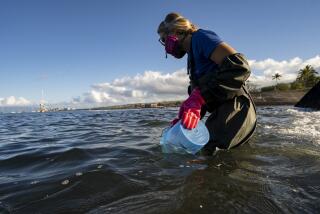Warm Oceans Threaten Caribbean Coral Reefs
The extremely warm ocean waters fueling this season’s record hurricane season are stressing coral reefs throughout the Caribbean and may kill 80% to 90% of the structures in some areas, scientists reported Monday.
These colorful undersea landmarks -- homes for tropical fish and magnets for divers and snorkelers -- are turning white, or “bleaching” in an area extending from the Florida Keys to Puerto Rico and Panama because of warmer-than-usual water that has persisted in the Atlantic for months.
“These levels are like nothing we’ve ever seen” in 20 years of satellite monitoring, said Al Strong, coordinator for the National Oceanic and Atmospheric Administration’s Coral Reef Watch. “It’s twice the thermal stress that we’ve ever seen for corals. We are talking extremely high percentage of bleaching and what seems to be extreme mortality.”
Coral bleaching started showing up in the Florida Keys this summer and has spread throughout much of the Caribbean. Puerto Rican scientists report that 85% to 95% of the coral reefs there were bleached, as were 70% of the reefs in Grenada.
“We are in the middle of the biggest bleaching event ever recorded in the Caribbean,” said Drew Harvell, an expert on coral at Cornell University who saw bleaching in more than half the reefs she recently surveyed off Panama.
This year’s bleaching episode worries scientists who have been watching a rapid decline of coral reefs around the world. Corals are sensitive animals that require clean, clear water that is warm -- but not too warm. In recent decades, clouding from excess sediment, fertilizer, sewage and other pollutants has taken a toll, while overfishing has removed many of the fish that graze algae off reefs and keep them clean.
The Caribbean is known for the fascinating shapes, colors and odd features of its many corals. About 80% of reefs there have been lost in the last three decades, said Nancy Knowlton, a coral reef expert who directs the Center for Marine Biodiversity and Conservation at Scripps Institution of Oceanography. “We now may be witnessing the rapid loss of [much] of what remains,” she added.
Coral reefs are the composite of millions of tiny animals, called polyps, that build hard exoskeletons of calcium carbonate. These skeletons fuse together in exquisite patterns that can resemble elk horns, brain tissue or unfurled fans.
A coral polyp thrives by absorbing micro-algae and sheltering it inside its skeleton. The algae, in turn, produce sugars that the corals use as food. This symbiotic relationship fails when ocean water gets too warm and the algae leave or are ejected. The polyp then withers, leaving only a ghostly white skeleton that looks as if it had been bleached.
Reefs can recover from bleaching over several decades if they are colonized by larvae from undamaged corals nearby. But repeated stresses from warming and other environmental assaults can permanently kill corals, including colonies that can live hundreds of years.
A strong El Nino in 1997 and 1998 devastated coral reefs around the world by bathing them in waters just one to two degrees Fahrenheit warmer than average. The toll was especially heavy in the Indian Ocean. Some corals succumbed to white band or other diseases. Others were covered in thick mats of algae and bacteria, their skeletons crushed to rubble by pounding waves.
This year, the overheating problems for corals are largely restricted to the Caribbean, but they are the most severe conditions coral watchers have ever seen because the still-elevated temperatures have lasted for 15 weeks, said NOAA’s Strong.
A team of scientists and managers from 98 countries estimated last year that 20% of the world’s coral reefs have been destroyed by human-induced problems and show no immediate prospects for recovery, 24% are at imminent risk of collapse and 26% are under longer-term threat of collapse.
On one bright note, scientists have discovered a heat-tolerant strain of algae in the Indian Ocean that can help reefs resist bleaching. But this strain does not appear to be spreading fast enough to protect the reefs from the increasing bleaching that is expected because of global warming.
In the last century, ocean temperatures have risen by nearly one degree Fahrenheit globally, a rise most scientists attribute to the emission of greenhouse gases into the atmosphere. Coral experts worry that over time, this warming could destroy the world’s coral.
The current warming in the Caribbean may be partly because of global warming, but scientists attribute most of it to a natural cycle of alternating warmer and cooler water that changes every few decades.
Since 1995, the ocean has been in a cycle of warmer waters and less wind shear -- conditions that are prime for forming strong hurricanes.
These warm conditions were last in place from the 1920s to the 1960s, when intense hurricanes were more common.
It is unclear how much corals suffered from warming in those decades because modern monitoring networks were not in place, said Julia E. Cole, a coral researcher at the University of Arizona who studies how reefs around the world have responded to climate change.
Yet corals then didn’t face the multitude of human-induced problems such as dynamiting reefs as a fishing technique, coastal development and increased use of fertilizers that run off from farms. Now, Cole said, corals also face global warming that will amplify problems brought on by natural warming cycles in the ocean.
“Coral bleaching is a stress response,” Cole said. “And corals are experiencing stresses that are probably unprecedented in recent millennia.”
More to Read
Sign up for Essential California
The most important California stories and recommendations in your inbox every morning.
You may occasionally receive promotional content from the Los Angeles Times.










